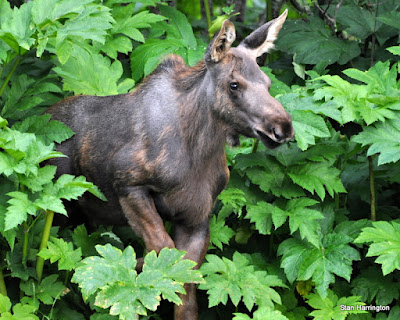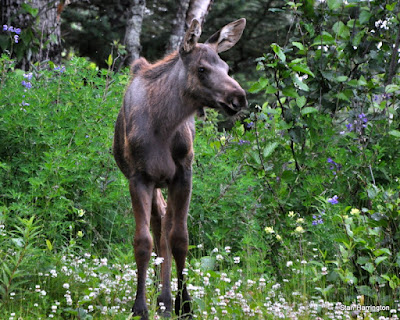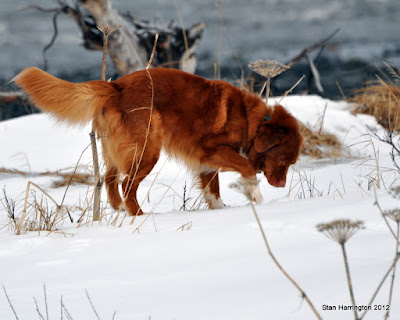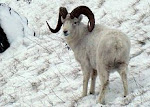Thursday, October 11, 2012
Elk In The Rut
Elk In The Rut
I have had the opportunity to photograph both the Mountain Elk and the Prairie Elk in my travels. This included the Elk of the Yukon Territory, British Columbia, and the majority of the western United States. My personal opinion is that the Elk is the most majestic of the Antlered Big Game Animals. You can never have a better experience than sitting with the Elk in the late evening and listening to the bugling of the Bull Elk. In the Black Hills of South Dakota, at the commencement of the rut, I had the opportunity to sit on a "Gathering of the Bulls" at daylight one morning. They were in a large meadow,just starting to move into the timber for the day. I was able to count twenty-two Bull Elk massed together at one time. A few of the younger Bulls were sparring with one another, the larger Bulls just looking on.
The photographs below were taken in Colorado, the morning after the first snow fall of the season in the high country. I sat with this herd and took countless photographs of this "Royal" Bull with his harem of sixteen cows. He maintained his "bugling" the entire time, inviting more Cows into his harem and warning other Bulls not to infringe on his territory. One young Bull did venture into the area, upon seeing the "Royal" challenging him, he quickly decided that he should clear the area.
"The "Royal" Standing Guard
"Bugling Bull"
"Bugling Bull"
"Starting To Mark A Tree With His Scent"
"Scenting The Tree"
"Persuading A Young Bull That He Was Intruding"
IT WAS A GREAT OPPORTUNITY AND A GREAT DAY
Saturday, September 22, 2012
The "Wild" Ones
"The Wild Ones"
While traveling from Alaska through Canada and throughout the western United States, I had the fortunate opportunity to observe and photograph wild horses in North Dakota, Wyoming, and Nevada. Although some of the herds are descendants of those horses brought north from Mexico by the early Spanish Explorers. Other herds are comprised of horses that have escaped or abandoned from the early days of settling the west or more recently when owners would let them loose to fend for themselves. I had the opportunity to spend several hours with this herd comprised of fifteen head located in the badlands of North Dakota.
I first spotted them high on a ridge that paralleled a small stream, being late in the afternoon I was hoping that they would move down to water. I positioned myself in the sage brush and patiently waited. It took forty-five minutes for them to work themselves into my photography range. I focused my attention on the four head of horses you see in these photographs. The Stud or Stallion was easy to identify, a big sorrel that had absolute control on the herd. The Lead Mare was identified early, a older Roan colored mare that always stayed in the lead with the stud. It was she that sounded the first alarm when she either spotted my movement of scent, then the stud took over. The Mare of the Colt was also easy to identify, like any mother the baby never strayed to far from her side. Looking at the Colt, there is no doubt who his daddy and mommy are; the big blaze on his face is almost identical to that of the Mare and Stallion. With age his coloration will also switch to the darker sorrel color.
Once, I was definitely discovered, the stud turned the herd with both verbal and body language. The Lead Mare took the lead when the herd turned and gallop back towards the ridge followed by the Mare, Colt and bringing up the rear was the Stallion. The timing and sequences of events were so perfectly timed it was as if it had been practiced many times. The forty-five minutes that I spent crouching in the sage brush, thinking a rattlesnake was going to sneak up on me was well worth the time and effort, most likely an event that will never be duplicated in my lifetime. Leaving the area, I felt very privileged to have witnessed the "The Wild Ones".
"Stallion Locating Me After Lead Mare Sounded Alarm"
"Stallion Sounding The Alarm And Turning The Herd"
Lead Mare Behind Stallion, Colt Between Stallion And Mother
"Mare And Colt"
"Stallion Turning The Herd, Mare And Colt Looking Straight On"
"A Second Verbal Alarm And Blocking The Mare and Colt"
"Stallion, Mare, and Colt Bringing Up The Rear Of The Herd"
Monday, September 17, 2012
Moose Lawn Ornaments
SUMMER 2012 GUESTS
At our home in Alaska, we are fortunate to have a fair size parcel of land of which the majority remains as natural habitat. Adjoining our home and lawn area, we have a large area that we refer to as the "meadow". With the sanctuary, each spring a number of Cow Moose will move into the area to give birth to their calves. After the calves have grown enough to keep up with mom, some of them will move to other locations in the river bottom. However, each spring we have a couple of Cows and Calves that prefer to stay and rear their young in the "meadow.
This summer was no exception, we had one resident Cow and Calf throughout the summer months. We affectionately named them "Thelma" and her calf received the name of "Butch". You could pretty much set your watch by her routine. Each evening, she would move her calf out of the meadow and onto our lawn. They would remain on the lawn throughout the night and return to the meadow each morning. They became adjusted to our routine, our dog "Dutch" would go outside with me, he ignored the Moose. The Cow would keep an eye on him but at no time did she ever express any anxiety or tension. Despite the large flower beds and decorator shrubbery, they were content on feeding on the natural flora and fauna along the edges of the lawn. They were Welcomed Guests and I am sure we will see "Thelma" the next time she has a calf to raise in the meadow.
"Thelma Checking Making A Security Sweep"
"Butch" Taking A Peek and A Bite Before Venturing Out"
"O.K. Safe To Come Out"
"Thelma In The Birch and Lupine"
"Thelma and Butch Grazing"
"Butch"
"Lunch Break"
Saturday, September 15, 2012
If The Walls Could Talk
In my travels of photographing the wildlife of North America, I am on the constant watch for old abandoned buildings that show their age and have continued to withstand time despite being subject to the elements. Each has a beauty of it's own unique style of construction and their aging process. As a youngster, I vividly recall one of my fathers sayings whenever he saw a home built of bricks. "When you build a house of wood, you are building a home but when you build a house of brick, you are building a monument." When photographing these old buildings, I can't help but wonder about the individuals that lived there. To know their history would be so fascinating and at the same time, you have to wonder to yourself why they chose that particular location to build and live. Each of these old buildings, would have so many stories to tell, if the walls could talk.
"Homestead Cabin" ~ Ohlson Mountain ~ Homer., Alaska
I utilized the front yard of this unique "Rock House" in Northern Nevada to camp while photographing Desert Big Horn Sheep. It is located about thirty miles off the main highway. A small corral was located on the property. The cabin was located directly under a large rock cliff. The best that guess I could make that perhaps at one time it was a gold miners home.
"A House Of Rock and Earthen Roof"
Perhaps the reason this home site was selected is that it was the only location in this area that trees were located, indicating the presence of water in barren badlands of North Dakota. Perhaps, it was a "line shack" utilized when grazing cattle during the summer months.
"Line Shack"
Barn of Wood and Silo of Brick in Nebraska. I am sure that this was a farmers pride, the quality of construction of the "Brick Silo" was amazing. Some old hand plows and rotten harnesses were located in the barn, leftovers of a farmers dream. A short distance from the barn were the signs of a second structure that had been destroyed by fire. Again, only assuming that it was the house, after the loss of the house did the farmer give up their farm or perhaps they two were lost in the fire.
"Farmers Pride"
Although now grey with age and abandoned, this barn and the home that has since fallen with age is all all that remains of a farmers dream in the prairies of Nebraska.
"Prairie Farm"
Discovered this little cabin nestled in the Aspen Trees in Northern, Colorado. The cabin is open to the nature, however, some remnants remained in the form of a table and hand hewn lumber bunk beds. The sole source of cooking and heating was a rock fireplace. At first glance, I thought perhaps it would have been ideal hideout for the outlaw gangs of yesteryear. However, just down the hill was a beautiful small stream (Pictured Below) which looked like you could walk alongside and pick up "Gold Nuggets" so once again I am assuming that this was perhaps a gold miners home.
"Cabin In The Quakies"
Wooden Grain Elevator in Eastern Montana. The uniqueness of this particular elevator is that there were living quarters in the lowest part of the building, assuming that the owner of the elevator utilized it as a business to hold the grain harvest for neighboring farmers until the end of the harvest. Then shipped it out by train since the railroad is visible behind the elevator. I am guessing that the owner would buy the grain from the farmer then hold it until the market prices increased, then sell it to the exchange. The only current occupants was a flock of pigeons.
"Storing The Harvest"
Thursday, September 13, 2012
Natural Beauty
"NATURAL BEAUTY"
Regardless of where you travel in our "Great Nation", the Natural Beauty is in the eyes of the beholder. Whether it be in the frontiers of Alaska, the high deserts of Nevada, the prairies of our Midwest, the altitudes of the Rocky Mountains, the East Coast, West Coast, Northern Border to the Southern Border. You just have to take the time to savor the moment and if you are fortunate snap a photo that will give you memories of that one particular moment in your life. This is just a sampling of some of those sights that I have been privileged to witness in my travels.
"Sunset On The Kansas Prairie"
"Sunset On Cook Inlet From Anchor Point, Alaska"
"Sunset In The Badlands of North Dakota"
"Fall Colors Od Southwestern Utah"
"September Evening At the Grand Canyon"
"Red Rock Formations of Southwest Utah"
"The Great One, Mount McKinley at Daylight"
"Daylight In Canyon Lands, Southwest Utah"
Friday, February 17, 2012
Winter Moose Range
The Anchor River Valley below our home is a traditional "Winter Moose Range", although in the past I have seen twenty to thirty Moose in a one mile section from the highway to the beach, this year we are once again seeing a smaller winter population. At the present time we have a dozen Cows, Calves, and some young immature Bulls in this area which is about all that it will currently support. Today, I was fortunate to have five Moose in close proximity of one another. A Cow which was feeding and this young Bull that decided it was time to take a afternoon nap. Unknown to him, but in a few short weeks his mother is going to kick him out of the nest. Chances are that she is pregnant and will be calving this spring. Prior to calving, she will abandon him to be on his own. In a couple of months, he will discover that he is no longer with his mother but he will also experience the growth of single "spike horns" sprouting from his forehead. The transition of mother / calf separation is evident. She was a hundred yards away from him feeding, when he decided to take a nap. Although, I was within feet of him, she paid me no attention.
The exact opposite was evident with the other three Moose in the area, a Cow and two Calves. They had also bedded down, but her calves were a year younger than the single Bull Calf. She kept her babies close to her, nestled against her to give them her body warmth. Although, she did not disturb her napping calves, she was very aware of my presence by keeping her eyes glued on me and flicking her ears. I gave her a wide berth so as not to disturb them, plus I cannot run as fast as she could if she decided that I was within her safety zone. Once again, a great opportunity to just witness and make attempt to figure out what was transpiring in their lives.
How many Moose do you see in this picture? If you count the ears, there are three Moose. This cow and two calves have bedded down for the afternoon, the one Calf behind the Cow never showed it's head. It was perfectly comfortable cuddled up against his /her mommy. The Calf in front of the Cow is also a young Bull Calf, his nubbins will grow a little this spring and summer but will not sprout as full spikes until next year.
"Alder Patch Bed"
First time that I have had the opportunity to shoot the full process of a Moose laying down, although they appear to be clumsy in the process, on their feet they are much faster and agile than their awkward appearance would indicate.
"Time For A Good Afternoon Nap"
Thursday, February 16, 2012
Traveling Buddy
"DUTCH"
Today, while I was out and about looking for subjects to photographed, I stopped by the beach area of Anchor Point to allow my traveling buddy a little time to play. He loves the beach and with the snow pack frozen, he was able to explore some new spots. While watching him, I realized that I very seldom photograph him when we travel.
For those that are not familiar with his breed, he is an AKC Registered Nova Scotia Duck Tolling Retriever. He will turn ten in March of this year. He was born at the Dutch Harbor Kennel in Dutch Harbor, Alaska. His Sire is Redventure's Artful Dodger and his Dam was Nibiru's Molly. His registered name with the American Kennel Club is Dutch Harbor Dutchman, but we just call him "Dutch".
He has put on a lot of miles with me, in the past two years we have logged 35 - 40,000 miles including two round trips over the Alcan Highway, three Canadian Provinces, and fifthteen states. We have had some great adventures and there will be more as we travel together.
"Temperature A Little Nippy On the Nose"
"Hard Pack Snow Provides A Good Back Scratch"
"Keeping An Eye On Me"
"Picking Up A Scent"
"Exploring the Scent"
"Windy Day"
"Time to Travel"
Subscribe to:
Comments (Atom)
































































